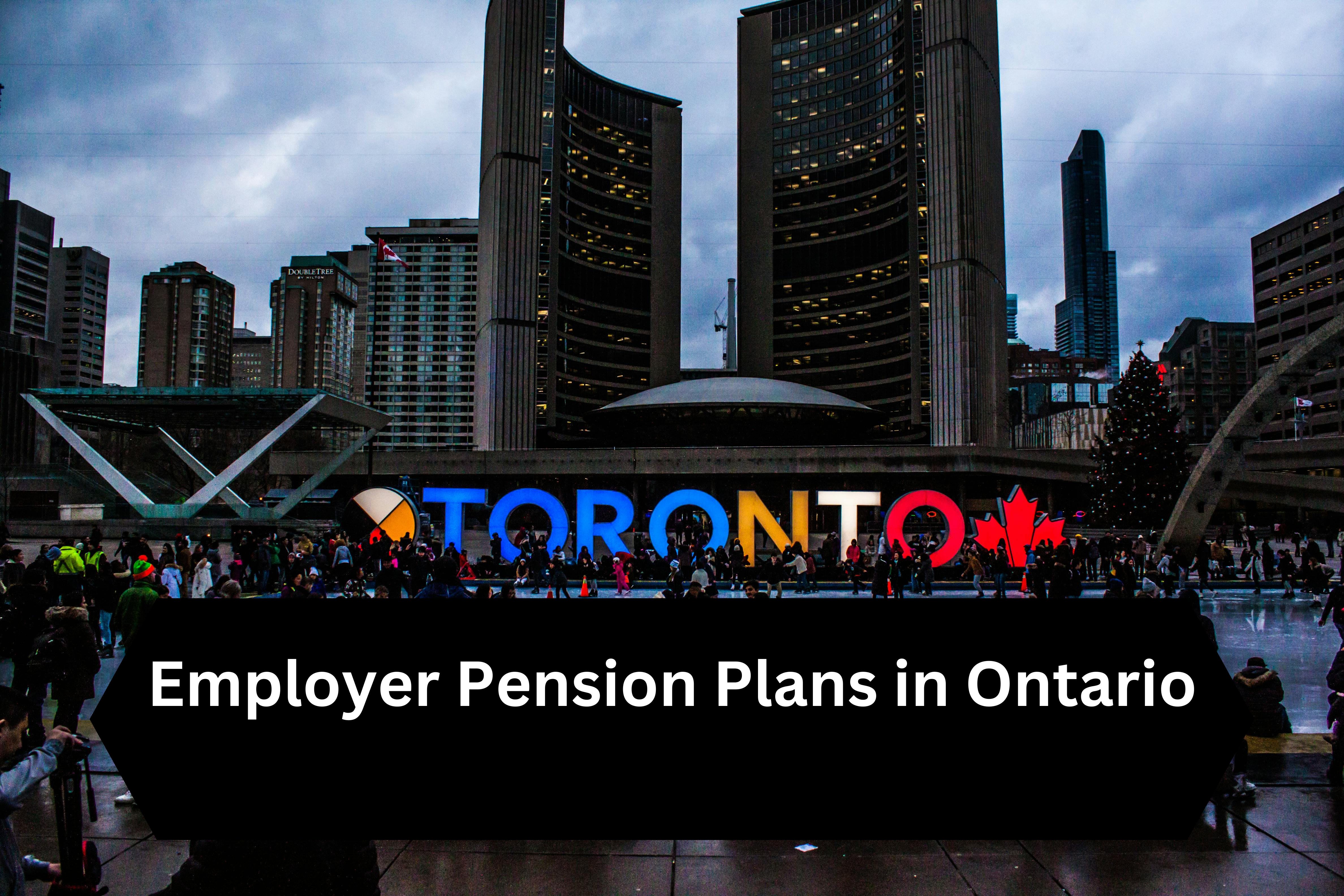Best Employer Pension Plans in Ontario: A Complete Guide

Employer pension plans are essential components of retirement planning, providing employees with financial security in their post-working years. These plans offer a structured method to accumulate savings, ensuring a steady income stream upon retirement. Participating in an employer-sponsored pension plan can significantly enhance an individual's ability to maintain their standard of living after exiting the workforce.
In Ontario, employees have access to various employer-sponsored pension plans, each with distinct features:
Defined Benefit (DB) Pension Plans: These plans promise a specific monthly benefit upon retirement, calculated based on factors like salary history and years of service. The employer bears the investment risk, ensuring a predictable income for retirees.
Defined Contribution (DC) Pension Plans: In these plans, contributions are defined, but the retirement benefit depends on the investment's performance. Both employers and employees contribute, and the accumulated funds are used to purchase retirement income. The investment risk is borne by the employee.
Group Registered Retirement Savings Plans (Group RRSPs): These are employer-sponsored RRSPs where contributions are made through payroll deductions. Employers may also contribute, and the funds grow tax-deferred until withdrawal.
Pooled Registered Pension Plans (PRPPs): Designed for employees of small businesses or self-employed individuals, PRPPs pool funds from multiple participants to achieve lower management costs and broader investment opportunities.
How to Choose the Right Pension Plan
Selecting the appropriate pension plan involves evaluating several factors:
Risk Tolerance: Determine your comfort level with investment risks. DB plans offer predictable benefits with minimal risk to the employee, whereas DC plans' outcomes depend on market performance.
Employer Contributions: Assess the extent of your employer's contributions, as generous matching can substantially boost retirement savings.
Portability: Consider the plan's portability, especially if you anticipate changing employers. Some plans allow transferring benefits to new employers or individual retirement accounts.
Financial Goals: Align the plan's features with your long-term retirement objectives, ensuring it supports your desired lifestyle post-retirement.
Disclaimer: This article is for informational purposes only and does not constitute legal, financial, or tax advice. Pension laws, tax regulations, and eligibility requirements may change over time. Consult with a qualified tax professional, financial advisor, or government agency for personalised guidance regarding your specific situation.
What is an Employer Pension Plan?
An Employer Pension Plan (EPP) is a retirement savings program established by an employer to assist employees in accumulating funds for their retirement. Both the employer and the employee typically make regular contributions to the plan, which are then invested to grow over time. Upon retirement, the accumulated funds provide the employee with a source of income.
Key Features of Employer Pension Plans:
Employer Contributions: Employers often match a portion of the employee's contributions, enhancing the growth of the retirement fund.
Tax Advantages: Contributions to EPPs are typically made on a pre-tax basis, reducing taxable income during working years. However, withdrawals during retirement are taxed as income.
Vesting Periods: Some plans require employees to remain with the company for a certain period before they gain full ownership of the employer-contributed funds.
Source [ Get Smarter About Money ]
Employer Pension Plans vs. Private Retirement Savings:
While EPPs are facilitated by employers, private retirement savings options like Registered Retirement Savings Plans (RRSPs) are individually managed. Key distinctions include:
Sponsorship: EPPs are employer-sponsored, whereas RRSPs are initiated and managed by individuals.
Contribution Matching: Employers may match contributions in EPPs, providing an immediate return on savings. RRSPs do not offer this benefit unless the employer chooses to contribute to an employee's RRSP.
Investment Control: RRSP holders have direct control over their investment choices, while EPP investments are typically managed by the plan administrators.
Example:
Consider an employee earning $70,000 annually who contributes 5% of their salary ($3,500) to a DCPP. If the employer matches this 5%, an additional $3,500 is contributed, totaling $7,000 in annual contributions. The retirement income will depend on how these contributions grow based on investment performance.
Also read; How to Retire in Ontario as a Foreigner
Types of Employer Pension Plans in Ontario
In Ontario, employer pension plans are essential components of retirement planning, providing employees with financial security in their later years. Understanding the various types of these plans is crucial for both employers and employees. The primary categories of employer pension plans in Ontario include:
1. Defined Benefit Pension Plans (DBPP)
Defined Benefit Pension Plans promise employees a specific monthly benefit upon retirement, calculated based on factors such as salary history and years of service. This type of plan provides predictable income, offering stability to retirees.
Example: A company might offer a DBPP where retirees receive 2% of their average salary during their highest-earning five years, multiplied by their total years of service. Therefore, an employee with an average top salary of $70,000 and 25 years of service would receive an annual pension of $35,000.
2. Defined Contribution Pension Plans (DCPP)
In Defined Contribution Pension Plans, employers, and often employees, contribute a fixed percentage of the employee's salary into an individual account. The retirement benefit depends on the amount contributed and the investment performance of those contributions.
Example: An employer contributes 5% of an employee's salary into a retirement account, with the employee optionally contributing an additional 5%. If an employee earns $60,000 annually, $3,000 from the employer and potentially $3,000 from the employee are invested each year. The retirement benefit varies based on the investment returns of these contributions.
3. Group Registered Retirement Savings Plans (Group RRSPs)
Group RRSPs are employer-sponsored plans where contributions are made to individual RRSP accounts for employees. These contributions are tax-deductible, and investments grow tax-free until withdrawal. Unlike pension plans, Group RRSPs are not subject to pension legislation, offering more flexibility but less security.
Example: An employer matches employee contributions up to 4% of their salary into a Group RRSP. An employee earning $50,000 who contributes $2,000 annually would receive an additional $2,000 from the employer, totaling $4,000 in annual contributions.
4. Deferred Profit Sharing Plans (DPSPs)
DPSPs allow employers to share profits with employees by making contributions to individual accounts, which grow tax-free until withdrawal. Only employers contribute to DPSPs, and contributions are often linked to company profits.
Example: A company experiencing a profitable year decides to contribute 10% of its profits to employees' DPSP accounts. An employee's share depends on the company's profit-sharing formula, which might consider factors like salary level and years of service.
Top Employer Pension Plans in Ontario
Ontario offers a variety of robust employer pension plans across both public and private sectors. Here's an overview of some of the top plans:
Government & Public Sector Pension Plans
Ontario Teachers’ Pension Plan (OTPP)
Overview: Established in 1990, OTPP serves over 340,000 active and retired teachers in Ontario. It stands as one of the largest pension plans globally, managing a diverse portfolio to ensure stable returns.
Key Features:
- Defined Benefit Plan: Guarantees a specific retirement income based on salary and years of service.
- Investment Strategy: Focuses on strategic investments across key markets and sectors.
Example: A teacher retiring after 30 years with OTPP can expect a predictable monthly income, calculated based on their average salary during their career.
Source: Ontario Teachers' Pension Plan
Healthcare of Ontario Pension Plan (HOOPP)
Overview: Founded in 1960, HOOPP provides pensions to Ontario's healthcare community, covering over 460,000 members across more than 670 employers.
Key Features:
- Defined Benefit Plan: Ensures lifetime pension income upon retirement.
- Investment Performance: Recognized for its strong investment strategies and consistent returns.
Example: A nurse enrolled in HOOPP can anticipate a stable monthly income after retirement, calculated based on their years of service and average salary.
Ontario Municipal Employees Retirement System (OMERS)
Overview: OMERS serves employees of local governments and related organizations across Ontario, managing a diversified global portfolio.
Key Features:
- Defined Benefit Plan: Provides predictable retirement income based on a formula considering salary and service years.
- Membership: Includes a wide range of municipal workers, from administrative personnel to public safety officials.
Example: A city planner employed by a municipal government and enrolled in OMERS can look forward to a steady pension post-retirement, determined by their salary history and years of service.
Source: OMERS
Top Private Sector Employer Pension Plans
Canada Pension Plan Investment Board (CPPIB)
Overview: CPPIB manages the funds of the Canada Pension Plan, investing globally to ensure long-term sustainability.
Key Features:
- Professional Management: Operates independently of the government with a mandate to maximize returns without undue risk.
- Diversified Investments: Spans various asset classes, including equities, real estate, and infrastructure.
Example: An individual contributing to the Canada Pension Plan benefits from CPPIB's investment strategies, which aim to provide retirement security for Canadians.
Bank & Financial Sector Pension Plans (RBC, TD, Scotiabank, BMO)
Overview: Major Canadian banks offer comprehensive pension plans to their employees, often combining defined benefit and defined contribution components.
Key Features:
- Employer Contributions: Banks typically match employee contributions up to a certain percentage.
- Additional Benefits: Plans may include supplementary retirement benefits and post-retirement health coverage.
Example: An employee at RBC participating in the company's pension plan receives matched contributions, enhancing their retirement savings over time.
Large Corporations Offering Great Pensions (Loblaw, Bell, Enbridge)
Overview: Several large corporations in Ontario provide competitive pension plans to attract and retain talent.
Key Features:
- Defined Contribution Plans: Employees and employers contribute to individual retirement accounts, with retirement income based on investment performance.
- Flexibility: Employees often have a range of investment options to choose from.Example: An Enbridge employee enrolled in the company's pension plan benefits from employer contributions and can select investment options aligning with their retirement goals.
Pros and Cons of Employer Pension Plans
Advantages:
Employer Contributions: Many employer pension plans include contributions from the employer, effectively boosting your retirement savings without additional personal expense.
Tax Benefits: Contributions to employer pension plans are often made on a pre-tax basis, reducing your taxable income for the year. Additionally, the growth within these plans is typically tax-deferred until withdrawal.
Guaranteed Income: Defined Benefit (DB) pension plans promise a specific monthly benefit upon retirement, providing predictable and stable income.
Disadvantages:
Limited Flexibility: In Defined Benefit plans, investment decisions are managed by the employer or plan administrators, limiting individual control over investment choices.
Portability Issues: Changing jobs can complicate pension benefits. While some plans allow for transfers, others may require leaving accrued benefits with the former employer, potentially affecting retirement income.
How to Maximize Your Employer Pension Plan
Best Strategies to Grow Your Pension Savings:
Maximize Employer Matching Contributions: Contribute at least the amount your employer is willing to match. This is essentially free money added to your retirement savings.
Stay Informed: Understand the details of your pension plan, including contribution limits, investment options, and plan performance. Regularly reviewing this information can help you make informed decisions.
How to Complement Your Pension with RRSPs and TFSAs:
Registered Retirement Savings Plans (RRSPs): Contributions to RRSPs are tax-deductible, and investments grow tax-deferred until withdrawal. This can supplement your employer pension by providing additional retirement income.
Tax-Free Savings Accounts (TFSAs): While contributions are not tax-deductible, withdrawals (including investment growth) are tax-free. TFSAs offer flexibility and can serve as an additional retirement savings vehicle.
Vesting Periods & Withdrawal Rules:
Vesting Periods: This is the time you must work before gaining full ownership of employer-contributed pension benefits. Understanding your plan's vesting schedule is important, especially if you're considering changing jobs.
Withdrawal Rules: Familiarise yourself with the rules regarding when and how you can access your pension funds, including any penalties for early withdrawal or mandatory withdrawal ages.
What Happens to Your Employer Pension If You Change Jobs?
Changing jobs can significantly impact your employer-sponsored pension plan. Understanding your options ensures you make informed decisions about your retirement savings.
Options When Leaving a Job:
Leave the Pension with Your Former Employer:
- Deferred Pension: You may choose to leave your accrued benefits in your former employer's plan, allowing them to grow until you reach retirement age. For example, the Ontario Pension Board (OPB) permits members to defer their pensions, enabling collection at age 65.
Transfer to a New Employer's Pension Plan:
- Portability: If your new employer offers a pension plan, you might transfer your accrued benefits, consolidating your retirement savings. For instance, OMERS allows transferring credited service to a new employer's registered pension plan.
Transfer to a Locked-In Retirement Account (LIRA):
- Preservation of Funds: Transferring your pension to a LIRA maintains the tax-deferred status of your savings until retirement. Institutions like National Bank of Canada outline this option for departing employees.
Cash Out the Pension:
- Immediate Access: Some plans allow withdrawing the pension's commuted value as a lump sum. However, this option may have tax implications and potential penalties.
Example: Consider an employee with a defined benefit pension plan who decides to leave their job. They could opt to leave their pension with the former employer, ensuring a steady income upon retirement, or transfer the value to a LIRA for more control over investments.
Key Considerations:
- Vesting Periods: Ensure you're entitled to employer contributions before making decisions.
- Comparative Benefits: Evaluate the benefits of the new employer's plan against the existing one.
- Tax Implications: Understand potential taxes or penalties associated with each option.
How to Enroll in an Employer Pension Plan & What to Ask HR
Enrolling in an employer-sponsored pension plan is a pivotal step toward securing your financial future. Engaging with your Human Resources (HR) department can provide clarity on plan specifics.
Enrollment Steps:
Confirm Eligibility:
- Employment Status: Determine if your position qualifies for pension benefits.
- Waiting Periods: Some employers impose a waiting period before enrollment.
Complete Necessary Documentation:
- Enrollment Forms: Fill out and submit required forms to HR.
- Beneficiary Designation: Specify who will receive benefits in your absence.
Understand Contribution Details:
- Employee Contributions: Know the percentage of your salary allocated to the plan.
- Employer Matching: Inquire about employer contribution matching policies.
Review Investment Options:
- Default Funds: Identify where contributions are invested by default.
- Alternative Choices: Explore other investment options available within the plan.
Questions to Ask HR:
- What type of pension plan is offered (Defined Benefit or Defined Contribution)?
- When do I become vested in the employer contributions?
- Are there options to make additional voluntary contributions?
- What are the available investment choices, and what are their associated risks?
- How can I access information about my pension balance and performance?
Example: An employee enrolling in a Defined Contribution plan should inquire about the range of investment options, associated fees, and tools available for monitoring investment performance.
Key Considerations:
- Stay Informed: Regularly review plan statements and updates.
- Seek Clarification: Don't hesitate to ask HR for detailed explanations on any aspect of the plan.
Challenges & Risks of Employer Pension Plans
While employer pension plans are valuable for retirement planning, they come with inherent challenges and risks that require attention.
1. Employer Solvency Risk:
- Bankruptcy Concerns: If an employer faces financial difficulties, it may impact the pension plan's ability to meet its obligations.
Example: Employees of a company that declares bankruptcy might face reduced pension benefits if the plan is underfunded.
2. Inflation Risk:
- Eroding Purchasing Power: Fixed pension benefits may not keep pace with inflation, diminishing retirees' purchasing power over time.
Example: A retiree receiving a fixed monthly pension may find that, over the years, the amount doesn't cover as many expenses due to rising costs.
3. Longevity Risk:
- Outliving Pension Benefits: There's a risk that retirees may outlive their pension benefits, especially if the plan doesn't provide lifetime income.
Example: A retiree with a pension designed to last 20 years may face financial challenges if they live beyond that period.
4. Investment Risk:
- Market Volatility: For Defined Contribution plans, the value of the pension depends on investment performance, exposing employees to market fluctuations.
Example: During economic downturns, the investments within a Defined Contribution plan may lose value, reducing the retirement savings of the plan holder.
Key Considerations:
- Diversification: Spread investments to mitigate risk.
- Regular Reviews: Periodically assess and adjust investment strategies.
- Stay Informed: Keep abreast of economic trends that may impact pension plans.
Sources:
Pension Risk Challenges | Defined Benefit Solutions | Sun Life



